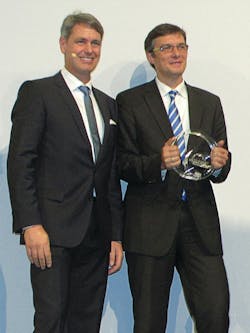Germany: Conductix-Wampfler wins Bavarian State Award (eCarTec Award) for Sustainable Mobility Concepts
A city bus powered by a combustion engine produces approximately the same amount of emissions as 50 diesel-powered cars – a disaster in ecological terms.
To date, however, very few transport associations have made the switch to the environmentally friendly electric buses: horrendous initial costs and insufficient range have called their cost-effectiveness into question. And yet the experts are unanimous: inductive charging technology can help electric buses achieve an economic breakthrough by enabling buses to be given small, regular energy boosts at bus stops.
As a result, batteries can be much smaller, and drive range and operating times significantly extended, meaning that the electric buses also reach the break-even point faster.
With the energy transmission system Inductive Power Transfer – or IPT for short – Conductix-Wampfler managed to outdo its competitors in the category “Sustainable Mobility Concepts.” The company was presented with the award at the International Trade Fair for Electric Mobility, eCarTec Munich. The technology of the IPT system permits automatic and efficient non-contact electricity transmission for electric buses. No other system has already proven its worth for so long in everyday operations.
Research confirms: Electric buses with opportunity charging are the most efficient
Researchers at the Karlsruhe Institute for Technology (KIT) have investigated in an independent study which drive system is the most economic for urban public-service buses. If public-service buses never have to fill up with diesel or petrol and are powered by electricity instead, this currently pays for itself on average within seven years, the KIT discovered. If you compare the Total Cost of Ownership (TCO) of a diesel and an electric bus, cost parity is achieved after seven years, assuming they cover an average 50,000 km per year. The KIT came to the conclusion that e-buses offer the greatest savings in energy costs over diesel buses. The larger or heavier a vehicle is, the greater the energy savings delivered by electric propulsion. An urban e-bus saves on average 35 cents per kilometre over a combustion-powered vehicle – in other words, the savings per kilometre are seven times those of an electric car.
The efficiency of heavy industrial vehicles such as public service e-buses can be enhanced even further if they are fitted with small batteries and receive regular short inductive charges. An added benefit is that the battery lifetime is extended by the small, regular energy boosts. The Turin transport company GTT has operated electric buses with IPT for over a decade and can confirm that maintenance costs have been 20 percent lower with IPT. Moreover, the service lifetime of the electric buses has been increased by 20 percent.
In 2012 a McKinsey study found that electric buses with opportunity charging (“opportunity e-buses”), alongside hydrogen-powered buses, hold the greatest potential for local public transport. On the other hand, simulations of the energy costs of commercial vehicles performed by the German Aerospace Centre (DLR) demonstrate that inductively charged e-buses deliver superior cost-effectiveness to hydrogen buses, a situation unlikely to change before 2030 What both studies confirm is that e-buses with opportunity charging have a key role to play in the urban passenger transportation of the future.
